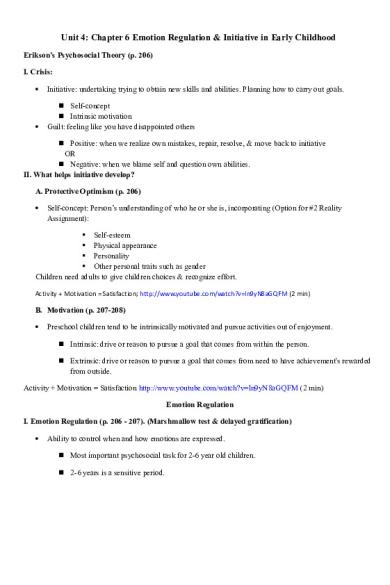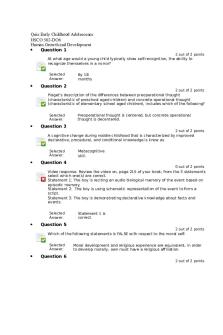Unit 4: Chapter 6 Emotion Regulation & Initiative in Early Childhood PDF

| Title | Unit 4: Chapter 6 Emotion Regulation & Initiative in Early Childhood |
|---|---|
| Course | Ss Human Development |
| Institution | Weber State University |
| Pages | 2 |
| File Size | 108 KB |
| File Type | |
| Total Downloads | 11 |
| Total Views | 137 |
Summary
Unit 4: Chapter 6 Emotion Regulation & Initiative in Early Childhood lecture notes...
Description
Unit 4: Chapter 6 Emotion Regulation & Initiative in Early Childhood Erikson’s Psychosocial Theory (p. 206) I. Crisis:
Initiative: undertaking trying to obtain new skills and abilities. Planning how to carry out goals.
Self-concept Intrinsic motivation Guilt: feeling like you have disappointed others
Positive: when we realize own mistakes, repair, resolve, & move back to initiative OR Negative: when we blame self and question own abilities. II. What helps initiative develop? A. Protective Optimism (p. 206)
Self-concept: Person’s understanding of who he or she is, incorporating (Option for #2 Reality Assignment):
Self-esteem Physical appearance Personality Other personal traits such as gender Children need adults to give children choices & recognize effort. Activity + Motivation = Satisfaction; http://www.youtube.com/watch?v=ln9yN8aGQFM (2 min)
B. Motivation (p. 207-208)
Preschool children tend to be intrinsically motivated and pursue activities out of enjoyment. Intrinsic: drive or reason to pursue a goal that comes from within the person. Extrinsic: drive or reason to pursue a goal that comes from need to have achievement's rewarded from outside.
Activity + Motivation = Satisfaction http://www.youtube.com/watch?v=ln9yN8aGQFM (2 min) Emotion Regulation I. Emotion Regulation (p. 206 - 207). (Marshmallow test & delayed gratification)
Ability to control when and how emotions are expressed. Most important psychosocial task for 2-6 year old children. 2-6 years is a sensitive period.
Brain maturation and social expectations lead to a decrease in temper tantrums and unrealistic fears, and increased self-control. II. How is the Brain Maturing? A. Prefrontal Cortex(p. 177)
Prefrontal cortex: front of the brain specializing in planning, and impulse control.
Myelination: the process through which axons are coated with a fatty substance (myelin) speeds transmission of nerve impulses between neurons.
B. Limbic System (p. 180)
Brain system crucial to developing emotional expression and regulation. Amygdala: A tiny brain structure that registers emotions, particularly fear and anxiety (nightmares & phobias). Hippocampus: A brain structure that is a central processor of memory, especially memory to location (summons anxiety provoking memories) Hypothalamus: A brain area that responds to the amygdala and the hippocampus to produce hormones that activate other prats of the brain and body (cortisol)
C. Connection between prefrontal cortext & limbic system is becoming stronger & more Integrated. D. Dan Siegel hand model of the brain & mindfulness (5 minutes) http://www.youtube.com/watch?
v=vESKrzvgA40 III. What helps Emotion Regulation Develop? Relationships, & Expectations (p. 206 - 207).
Marshmallow Test revised: http://www.youtube.com/watch?v=JsQMdECFnUQ
Play (p. 212-216)
Most productive and enjoyable activity that all children in the world undertake.
Play becomes more social during preschool. o Rough & Tumble play: Is universal, mimics aggression through wrestling, chasing, or hitting, but in which there is no intent of harm. o Sociodramatic play: Is universal, pretend play in which children act out various roles and themes in stories that they create....
Similar Free PDFs

Transition in early childhood
- 4 Pages

ICT in Early Childhood Education
- 3 Pages

Early Childhood Case Study
- 10 Pages

Andres Bonifacio Early Childhood
- 12 Pages

Quiz Early Childhood Adolescence
- 9 Pages

Early Childhood project
- 4 Pages
Popular Institutions
- Tinajero National High School - Annex
- Politeknik Caltex Riau
- Yokohama City University
- SGT University
- University of Al-Qadisiyah
- Divine Word College of Vigan
- Techniek College Rotterdam
- Universidade de Santiago
- Universiti Teknologi MARA Cawangan Johor Kampus Pasir Gudang
- Poltekkes Kemenkes Yogyakarta
- Baguio City National High School
- Colegio san marcos
- preparatoria uno
- Centro de Bachillerato Tecnológico Industrial y de Servicios No. 107
- Dalian Maritime University
- Quang Trung Secondary School
- Colegio Tecnológico en Informática
- Corporación Regional de Educación Superior
- Grupo CEDVA
- Dar Al Uloom University
- Centro de Estudios Preuniversitarios de la Universidad Nacional de Ingeniería
- 上智大学
- Aakash International School, Nuna Majara
- San Felipe Neri Catholic School
- Kang Chiao International School - New Taipei City
- Misamis Occidental National High School
- Institución Educativa Escuela Normal Juan Ladrilleros
- Kolehiyo ng Pantukan
- Batanes State College
- Instituto Continental
- Sekolah Menengah Kejuruan Kesehatan Kaltara (Tarakan)
- Colegio de La Inmaculada Concepcion - Cebu









